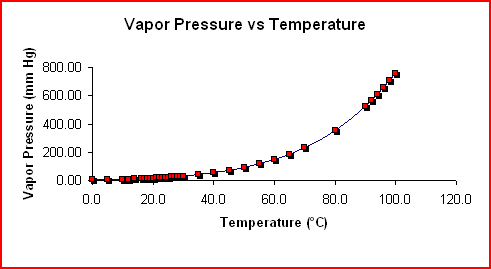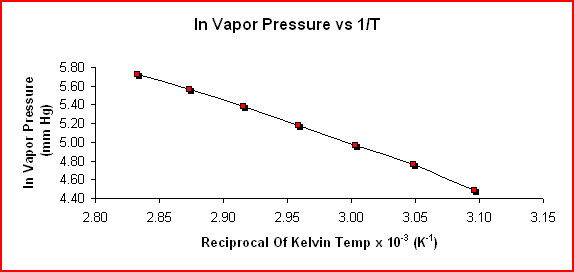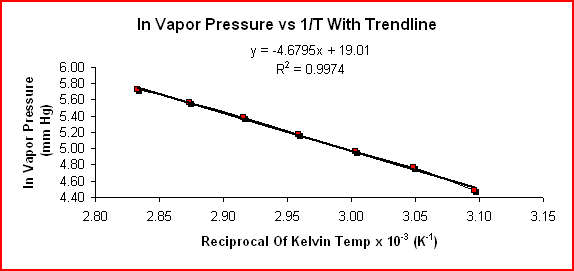Enthalpy Of Vaporization Of Water

Vapor pressure of a liquid is the pressure exerted by its vapor when the liquid and vapor states are in equilibrium. This quantity is an intensive property of a given liquid at a particular temperature which depends on the magnitude of the intermolecular forces. For example, at 25° C, the vapor pressure of water is 24 mm Hg while that of benzene is 92 mm Hg. The difference in pressure at the same temperature is the result of hydrogen bonding found in water (see Hydrogen Bonding).
The vapor pressure of a liquid is temperature dependent meaning that it increases with an increase in temperature. A plot of Vapor Pressure vs Temperature for water is shown below. As seen from the graph, it is a curve with a steady increasing slope.
 |
Graphs such as these are tedious to construct and interpret.
An easier graph to interpret and analyze results when the natural log of the vapor pressure (ln P) is plotted versus the reciprocal of the Kelvin temperature (T -1 (K -1)).
 |
The graph results in a straight line graph whose general equation is given by:
ln P = A - ΔHvap/RT
ΔHvap is the heat of vaporization of the liquid in J/mol and R is the universal gas constant whose value is
8.31 J/mol•K. The quantity A is constant for a particular liquid but for the present consideration, it can be ignored.
Applying the equation ln P = A - ΔHvap/RT at any two points on the graph yields:
T2: ln P2 = A - ΔHvap/RT2
T1: ln P1 = A - ΔHvap/RT1
To eliminate the constant A, the two equations are subtracted.
ln P2 - ln P1 = -ΔHvap/R[1/T2 - 1/T1] = ΔHvap/R[1/T1 - 1/T2]
ln (P2/ P1) = -ΔHvap/R[1/T2 - 1/T1] = ΔHvap/R[1/T1 - 1/T2]
The above equation is the Clausius-Clapeyron equation.
The Clausius-Clapeyron equation fits the straight line equation y = mx + b, where y is equal to the ln (P2/ P1), x is equal to 1/T, and the slope is equal to, Δy/Δx = -ΔHvap/R.
Using the slope of the graph shown below, ΔHvap for water can be calculated:
ΔHvap = Δy/Δx • R = 4.6795 K x 8.31 J/mol•K x 1 kJ/103 J = 38.9 kJ/mol.
The value for ΔHvap = 38.9 J/mol is in close agreement to the accepted value of 40.7 kJ/mol.
 |